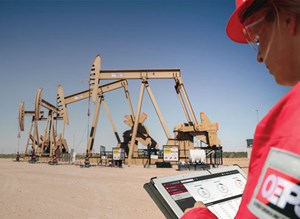Autonomous well management system increases uptime
Most oil and gas operators can reduce their work’s mantra down to one simple quest for excellence: Safely achieving greater production with fewer dollars. For decades, this pursuit has driven many advances in optimization, including fracturing in completions and significant efficiency gains in drilling. However, each of these disciplines have essentially experienced plateaus in their advancement and remained stagnant. Production, however, holds last remaining frontier.
NEW MANAGEMENT SYSTEM
Industry 4.0 represents the next revolution of industrial innovation and now presents new opportunities for elevating oilfield production performance to new domains of efficiency, control, and recovery. Weatherford refers to this realm as “Production 4.0” and has leveraged its two production software platforms – ForeSite and CygNet IoT / SCADA – to bring the advantages of Industry 4.0 to oil and gas production. As the backbones of this new capability, these platforms now monitor and optimize more than 460,000 wells worldwide and manage 125,000 mi of oil and gas pipeline with 30 billion updates each day. Early results indicate that Production 4.0 unveils management efficiencies that empower operators to capitalize on an easy-to-reach and plentiful resource – their own data.
The essential elements that comprise Production 4.0 are the internet of things (IoT), cloud computing, edge connectivity, and advanced data analytics. IoT is comprised of digitally connected physical devices that add systematic support and efficiencies through empirical data and remote controls. Cloud computing allows these devices to network through Internet-hosted servers that store and manage data while reducing infrastructure and complexity. Edge computing then elevates this connectivity with intelligent devices that can make real-time, autonomous decisions based on live data and historical models.
By linking these technological components, Production 4.0 empowers an organization with operations-level decision making without human involvement. This elevates operator strategy to leverage the next industrial superpower – big data. Intelligent ecosystems armed with analytics can now glean meaningful, actionable insight from a pristine data source. Personnel no longer have the burden of managing lower-level transactions. Analytics is here to help to identify trends and anomalies, which provides opportunities for enhanced efficiency and higher performance. For the oilfield industry, data analytics enables intelligent production machines to improve themselves on the fly. These analytics also predict equipment failures for just-in-time maintenance and allow operators to manage only by exception.
FIELD APPLICATION
A reciprocating rod-lift pumping unit can now house an onboard sensory system that is continuously updated by imbedded well-engineering models, Fig. 1. These sensors can instantly detect anomalies and developing trends throughout the artificial-lift system. In response to any variations in production, the unit can access a knowledge base accumulated from millions of downhole cards and oilfield scenarios to independently decide what changes should be made to maximize production.
For example, if a formation begins releasing extra fluids into a wellbore, this influx would automatically trigger the calculations needed to determine that an under-pumped well is developing. A fully automated system can compute setpoint adjustments and optimize the surge. The controller would be instantly cued with an accelerated pump regime that precisely maximizes production. Remarkably, an artificial-lift system can earn its operator more total production – without human intervention.
Looking from outside this scenario, nothing significant will appear to have happened. The pumping unit continues pumping regardless. However, an invisible adjustment such as this represents a revolutionary breakthrough for oil and gas operators worldwide. Gone are the days when this situation would go undetected, or at best, take weeks to discover by scheduled maintenance. A new level of self-governing production has arrived. The age of the intelligent, autonomous wellsite is here.
The key to this autonomous intelligence is an IoT, or SCADA system that brings all data streams from every part of an oil and gas operation into a single and unified platform. Production-optimization software then uses this data to act as a field-wide intelligence system to optimize artificial-lift and surface-facility efficiency. Leveraging this data empowers operators to not only increase equipment run life, but also maximize production while making it as profitable and economically viable as possible. These systems continuously monitor asset performance, give operators remote control over component-level assets, and enable more informed production decisions.
The final link in this revolution is in the Cloud. With cloud computing, users can create an elastic production ecosystem that is both scalable and flexible – a major advantage to operators. Cloud solutions let users easily capitalize on business opportunities without incurring additional costs, which is ideal as enterprises expand in well count or asset base, cross geographical borders, or increase in complexity.
OPTIMIZATION ON THE EDGE
Production 4.0 represents next-generation automation. Paired with IoT-enabled equipment, pipelines, and surface facilities, edge computing launches data analytics into action. This powerful combination acquires, stores, and streams high-frequency data, offers secure communication in the form of IoT-based instant notifications, provides optimization models on the edge, and enables autonomous control of the artificial-lift system. Weatherford has incorporated all the components of Industry 4.0 into its optimization platform, ForeSite Edge.

The primary advantage of Edge optimization is advanced data analytics. ForeSite software combines machine-learning techniques and physics-based models to determine the optimal lift settings and surface infrastructure in real time, Fig. 2. Not only that, the software can predict when and why artificial-lift equipment will fail. This enterprise-level platform offers predictive analytics for the two most common forms of artificial lift – rod lift and ESP – to give operators new insights. As a result, operators can proactively dispatch maintenance crews to reduce downtime and associated production losses.
Integrated with an existing controller or offered with built-in automation, this technology at the edge gathers and analyzes historical-trends and real-time production data. Production 4.0 systems have the capacity to employ years of sub-second, real-time sensor data from the wellsite then use a suite of comprehensive calculation and modeling engines – including physics-based well models – to optimize production. Users can also import models from third-party technologies for even more flexibility and scale.
The rod-lift scenario described above is a common problem facing oilfield operators and exemplifies how the system provides an immediate advantage. ForeSite Edge autonomously manages pump idle times to eliminate both over-pumping, which causes equipment failure, or under-pumping, which leaves valuable hydrocarbons in the well. For gas-lift wells, the technology autonomously manages injection gas to optimize the use of limited assets.
ZERO-DELAY ALERTS
Traditional SCADA systems base all optimization decisions off just a few snapshots of data that is retrieved, or pulled, from the well each day. Oftentimes, polling data may be completed just once per hour. Therefore, any variance in flow that occurs immediately after a polling cycle is performed, will leave the operator painfully exposed to NPT as well as potential hazards to equipment and personnel. The actual performance characteristics of the well may remain unknown until the next scheduled polling cycle.

For example, if a well goes down on an alarm, an hour may pass before anyone is alerted to the situation. If a well starts slugging beyond preset norms, or if production conditions fluctuate, the issue may never be known unless someone happens to be actively monitoring real-time data at the wellsite or home office.
Edge-based systems deliver instant, intelligent IoT-data notifications – giving operators immediate notice when wells need human intervention, Fig. 3. Without a second of delay, ForeSite Edge alerts users to failures, slugging, and equipment imbalance. It also signals when operating parameters pass critical limits. And because the system harnesses predictive analytics, users can receive alerts before a lift system fails. These instantaneous notifications enable immediate corrective action and minimize HSSE impacts, reduce downtime, and enhance personnel safety.
HIGH-FREQUENCY INTELLIGENCE
In a traditional rod-lift scenario, operators can typically analyze their rod-lift systems based on one to three dynamometer cards per day from a legacy controller. However, Edge computing enables high-frequency data by which each stroke is recorded, analyzed, and stored.
The operating conditions of any well are dynamic. Yet knowing this, operators will often rely on just a simple review from just one current card, full card, and pump-off card per day. Considering a well that is running 24/7 at six-strokes/minute means all operational decisions are based on a well sample that is less than 0.01 percent of operating data. Edge computing eliminates this exposure.
With high-frequency data availability and storage on the Cloud, ForeSite Edge gives operators insight into the true health of a well, including conditions that may otherwise be impossible to detect. For example, operators will often have a few problem wells with failure frequencies three-to-five times higher than other similar wells. However, when reviewing these small snapshots of data from the past, there will be no sign of anomalies in a well’s operations. When well cards from every stroke are available, operators can accurately understand how the well is operating and make informed decisions to optimize the well, extend mean time between failures, and reduce NPT.
LOOKING FORWARD
Production holds the next big oilfield breakthrough for operators worldwide. The digital age of data analytics and predictive-failure management present huge potential for gaining significantly more production and operational efficiency in a safer, more cost-effective manner. Production 4.0 technologies and optimization intelligence will drive this next phase of oilfield efficiency. Data-driven platforms are the future of artificial-lift systems and will continue playing more varied roles in the industry. With functionalities and capabilities that are in no way limited to the production phase, the next plateaus of operational efficiencies are not only limitless, but easily within reach today.
- Digital transformation/Late-life optimization: Harnessing data-driven strategies for late-life optimization (March 2024)
- The reserves replacement dilemma: Can intelligent digital technologies fill the supply gap? (March 2024)
- Digital tool kit enhances real-time decision-making to improve drilling efficiency and performance (February 2024)
- Digital transformation: Digital twins help to make the invisible, visible in Indonesia’s energy industry (January 2024)
- Digital transformation: A breakthrough year for digitalization in the offshore sector (January 2024)
- Quantum computing and subsurface prediction (January 2024)



